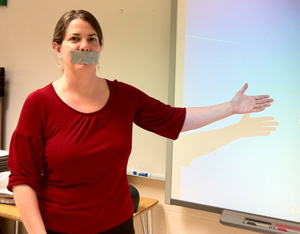NO: by Daniel Wang
Teachers rarely express personal opinions in class. It’s almost a given that students don’t know a particular teacher’s political or religious beliefs, because the classroom doesn’t seem like the right place for such proclamations of belief. Our school administration reinforces this idea, aiming to “ensure balance of materials and instruction” without any teacher opinions, and it’s a sound policy. There’s little room for politics and religion in the classroom, and none at all for a teacher’s expression of belief.
Some may ask, Why does this seeming double standard exist? Why can ordinary people express their beliefs, but a teacher cannot? The answer lies in the difference in environment. A classroom environment is different from the everyday world. It must be, because the primary goal of the classroom is to provide a suitable setting for learning. Personal opinions on politics, religion, or current events can be welcomed in everyday life, but they should stay outside of school, if only because these opinions don’t foster learning of standard curriculum. A teacher’s discussion of politics takes away from class time that could, and should, be used for teaching class material.
This argument is admittedly less effective, though, when discussing Social Studies classes in which current events play a major role, such as Comparative Politics or US Government. It’s true that religious or political debates, when kept under control, can be interesting, sometimes enlightening. Given this role of debate in learning, it seems acceptable for politics and religion to occasionally enter the classroom. However, these debates can take place without a teacher making a clear stand on either side. In the words of Mr. Moran, an MHS Social Studies teacher, “How would [teachers’ opinions] aid the learning process?” Instead, the best role for a teacher to play is devil’s advocate, seeking holes in the arguments of both sides to promote further discussion. If a teacher expresses an opinion on a political or religious subject, he/she doesn’t promote dialogue. Instead, to students, that opinion becomes a credible statement on the world from an authority figure. The classroom is a place to learn, and a teacher’s expression of belief is an act of persuasion, not instruction.
The role of a teacher is to teach. Expressing political or religious belief isn’t teaching, it’s a form of persuasion that imbalances students’ learning on a topic. Teachers must provide evidence for both sides of a debate with no clear answer and allow students to choose their own opinions. This is teaching; this creates critical thinking skills, not indoctrination of one side over another.
Yes: by Rachel Yang
Minnetonka’s classrooms are supposed to be areas of learning—neutral learning—where we can form opinions for ourselves out of bare facts.
But there’s bias everywhere; it’s inescapable. Even some of our textbooks or educational videos present biases. When we’re exposed to such sources in class, we’re asked to consider the reliability of fictional narrators or the opinions of writers, speakers or artists. Can we not be expected to do the same with our teachers’ lessons?
When we leave behind these desks, iPads, and SmartBoards for college lecture halls or the workforce or anywhere outside our cozy Tonka Bubble, we’re going to encounter blatant bias and opinion—yes, even from our professors and bosses and superiors. Why can’t we as students be trusted to deal with bias in high school? Why can’t our high school experience prepare us a little more in this respect for “the real world”?
As teenagers, we’re in a stage where we suddenly find ourselves developing personal ideologies and discover that we’re unsure how to argue our points without forcing it down one another’s throats. I think we should be learning to express our viewpoints effectively and respectfully. And I think that teachers sharing their own opinions would be valuable in this process.
I’m not arguing that teachers should share all their opinions with their students, but I don’t think they should be prohibited from doing so. It’s true that we learn more from our high school classes than just the curriculum, and it’s true that teachers are influential figures for high school students. But that doesn’t mean that teachers need to be excessively stingy with their opinions for fear of being “too influential.” In a classroom setting, it can be helpful for students to see opinions presented logically and reasonably by an authority figure.
We all make bets, anyway. We snag a passing comment our teacher makes during a lesson and whisper about it amongst ourselves, trying to guess at his or her political views. So why not just go for full disclosure? If we’re addressing a topic in class with several established opposing viewpoints, wouldn’t it be beneficial to neutral classroom instruction if teachers prefaced the lesson with their own views or beliefs on the issue? This accounts for any perceived bias in their lesson, and they can better achieve classroom neutrality. In cases like this, teachers can use the expression of opinions as a teaching tool.
The lesson is that opinions don’t have to be dogmatic and overbearing. One can share an opinion and still teach without imposing beliefs on students.































